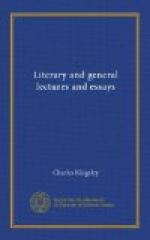And this is, to my mind, the difference, and the noble difference, between the so-called Norman architecture, which came hither about the time of the Conquest; and that of Romanised Italy.
But the Normans were a conquering race; and one which conquered, be it always remembered, in England at least, in the name and by the authority of Rome. Their ecclesiastics, like the ecclesiastics on the Continent, were the representatives of Roman civilisation, of Rome’s right, intellectual and spiritual, to rule the world.
Therefore their architecture, like their creed, was Roman. They took the massive towering Roman forms, which expressed domination; and piled them one on the other, to express the domination of Christian Rome over the souls, as they had represented the domination of heathen Rome over the bodies of men. And so side by side with the towers of the Norman keep rose the towers of the Norman cathedral— the two signs of a double servitude.
But with the thirteenth century there dawned an age in Northern Europe which I may boldly call an heroic age—heroic in its virtues and in its crimes; an age of rich passionate youth, or rather of early manhood; full of aspirations of chivalry, of self-sacrifice as strange and terrible as it was beautiful and noble, even when most misguided. The Teutonic nations of Europe—our own forefathers most of all—having absorbed all that heathen Rome could teach them, at least for the time being, began to think for themselves; to have poets, philosophers, historians, architects, of their own. The thirteenth century was especially an age of aspiration; and its architects expressed, in building, quite unlike those of the preceding centuries, the aspirations of the time.
The Pointed Arch had been introduced half a century before. It may be that the Crusaders saw it in the East and brought it home. It may be that it originated from the quadripartite vaulting of the Normans, the segmental groins of which, crossing diagonally, produced to appearance the pointed arch. It may be that it was derived from that mystical figure of a pointed oval form, the vesica piscis. It may be, lastly, that it was suggested simply by the intersection of semicircular arches, so frequently found in ornamental arcades. The last cause may perhaps be the true one; but it matters little whence the pointed arch came. It matters much what it meant to those who introduced it. And at the beginning of the Transition or semi-Norman period, it seems to have meant nothing. It was not till the thirteenth century that it had gradually received, as it were, a soul, and had become the exponent of a great idea. As the Norman architecture and its forms had signified domination, so the Early English, as we call it, signified aspiration—an idea which was perfected, as far as it could be, in what we call the Decorated style.




